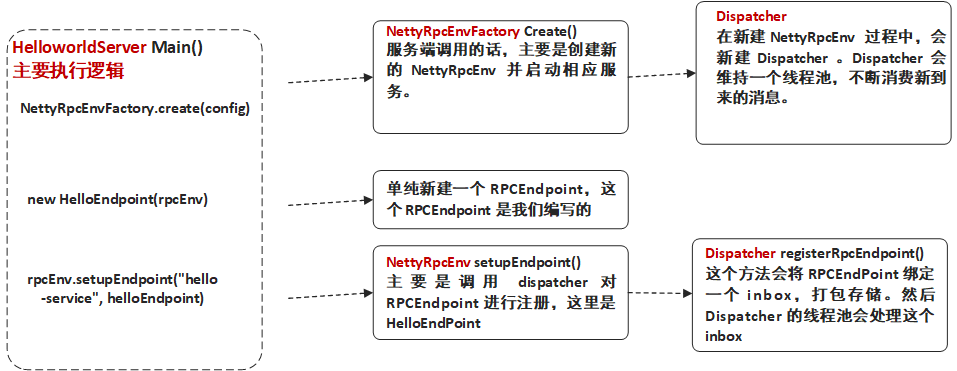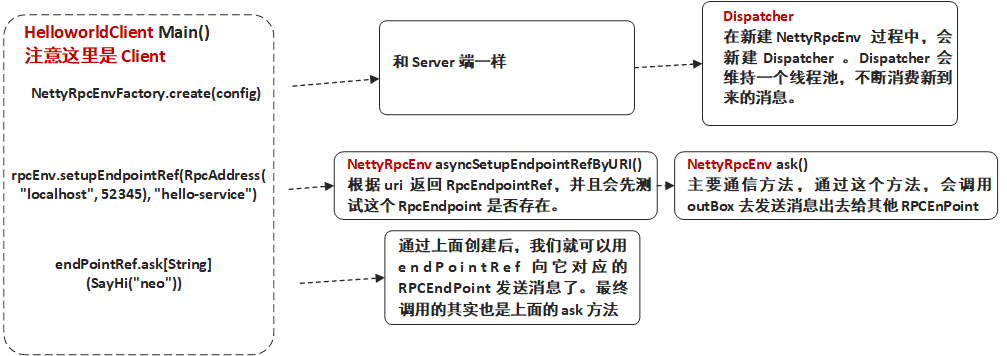Spark RPC 框架的運行時序是怎樣的呢?讓我們深入到它的源碼裡面去看看~~ ...
前情提要:
一. Spark RPC概述
上一篇我們已經說明瞭Spark RPC框架的一個簡單例子,Spark RPC相關的兩個編程模型,Actor模型和Reactor模型以及一些常用的類。這一篇我們還是用上一篇的例子,從代碼的角度講述Spark RPC的運行時序,從而揭露Spark RPC框架的運行原理。我們主要將分成兩部分來講,分別從服務端的角度和客戶端的角度深度解析。
不過源碼解析部分都是比較枯燥的,Spark RPC這裡也是一樣,其中很多東西都是繞來繞去,牆裂建議使用上一篇中介紹到的那個Spark RPC項目,下載下來並運行,通過斷點的方式來一步一步看,結合本篇文章,你應該會有更大的收穫。
PS:所用spark版本:spark2.1.0
二. Spark RPC服務端
我們將以上一篇HelloworldServer為線索,深入到Spark RPC框架內部的源碼中,來看看啟動一個服務時都做了些什麼。
因為代碼部分都是比較繞的,每個類也經常會搞不清楚,我在介紹一個方法的源碼時,通常都會將類名也一併寫出來,這樣應該會更加清晰一些。
HelloworldServer{
......
def main(args: Array[String]): Unit = {
//val host = args(0)
val host = "localhost"
val config = RpcEnvServerConfig(new RpcConf(), "hello-server", host, 52345)
val rpcEnv: RpcEnv = NettyRpcEnvFactory.create(config)
val helloEndpoint: RpcEndpoint = new HelloEndpoint(rpcEnv)
rpcEnv.setupEndpoint("hello-service", helloEndpoint)
rpcEnv.awaitTermination()
}
......
}
這段代碼中有兩個主要流程,我們分別來說
2.1 服務端NettyRpcEnvFactory.create(config)
首先是下麵這條代碼的運行流程:
val rpcEnv: RpcEnv = NettyRpcEnvFactory.create(config)
其實就是通過 NettyRpcEnvFactory 創建出一個 RPC Environment ,其具體類是 NettyRpcEnv 。
我們再來看看創建過程中會發生什麼。
object NettyRpcEnvFactory extends RpcEnvFactory {
......
def create(config: RpcEnvConfig): RpcEnv = {
val conf = config.conf
// Use JavaSerializerInstance in multiple threads is safe. However, if we plan to support
// KryoSerializer in future, we have to use ThreadLocal to store SerializerInstance
val javaSerializerInstance =
new JavaSerializer(conf).newInstance().asInstanceOf[JavaSerializerInstance]
//根據配置以及地址,new 一個 NettyRpcEnv ,
val nettyEnv =
new NettyRpcEnv(conf, javaSerializerInstance, config.bindAddress)
//如果是服務端創建的,那麼會啟動服務。服務端和客戶端都會通過這個方法創建一個 NettyRpcEnv ,但區別就在這裡了。
if (!config.clientMode) {
val startNettyRpcEnv: Int => (NettyRpcEnv, Int) = { actualPort =>
//啟動服務的方法,下一步就是調用這個方法了
nettyEnv.startServer(config.bindAddress, actualPort)
(nettyEnv, nettyEnv.address.port)
}
try {
Utils.startServiceOnPort(config.port, startNettyRpcEnv, conf, config.name)._1
} catch {
case NonFatal(e) =>
nettyEnv.shutdown()
throw e
}
}
nettyEnv
}
......
}還沒完,如果是服務端調用這段代碼,那麼主要的功能是創建RPCEnv,即NettyRpcEnv(客戶端在後面說)。以及通過下麵這行代碼,
nettyEnv.startServer(config.bindAddress, actualPort)
去調用相應的方法啟動服務端的服務。下麵進入到這個方法中去看看。
class NettyRpcEnv(
val conf: RpcConf,
javaSerializerInstance: JavaSerializerInstance,
host: String) extends RpcEnv(conf) {
......
def startServer(bindAddress: String, port: Int): Unit = {
// here disable security
val bootstraps: java.util.List[TransportServerBootstrap] = java.util.Collections.emptyList()
//TransportContext 屬於 spark.network 中的部分,負責 RPC 消息在網路中的傳輸
server = transportContext.createServer(bindAddress, port, bootstraps)
//在每個 RpcEndpoint 註冊的時候都會註冊一個預設的 RpcEndpointVerifier,它的作用是客戶端調用的時候先用它來詢問 Endpoint 是否存在。
dispatcher.registerRpcEndpoint(
RpcEndpointVerifier.NAME, new RpcEndpointVerifier(this, dispatcher))
}
......
}執行完畢之後這個create方法就結束。這個流程主要就是開啟一些服務,然後返回一個新的NettyRpcEnv。
2.2 服務端rpcEnv.setupEndpoint("hello-service",helloEndpoint)
這條代碼會去調用NettyRpcEnv中相應的方法
class NettyRpcEnv(
val conf: RpcConf,
javaSerializerInstance: JavaSerializerInstance,
host: String) extends RpcEnv(conf) {
......
override def setupEndpoint(name: String, endpoint: RpcEndpoint): RpcEndpointRef = {
dispatcher.registerRpcEndpoint(name, endpoint)
}
......
}我們看到,這個方法主要是調用dispatcher進行註冊的。dispatcher的功能上一節已經說了,
Dispatcher的主要作用是保存註冊的RpcEndpoint、分發相應的Message到RpcEndPoint中進行處理。Dispatcher即是上圖中ThreadPool的角色。它同時也維繫一個threadpool,用來處理每次接受到的 InboxMessage。而這裡處理InboxMessage是通過inbox實現的。
這裡我們就說一說dispatcher的流程。
dispatcher
dispatcher在NettyRpcEnv被創建的時候創建出來。
class NettyRpcEnv(
val conf: RpcConf,
javaSerializerInstance: JavaSerializerInstance,
host: String) extends RpcEnv(conf) {
......
//初始化時創建 dispatcher
private val dispatcher: Dispatcher = new Dispatcher(this)
......
}dispatcher類被創建的時候也有幾個屬性需要註意:
private[netty] class Dispatcher(nettyEnv: NettyRpcEnv) {
......
//每個 RpcEndpoint 其實都會被整合成一個 EndpointData 。並且每個 RpcEndpoint 都會有一個 inbox。
private class EndpointData(
val name: String,
val endpoint: RpcEndpoint,
val ref: NettyRpcEndpointRef) {
val inbox = new Inbox(ref, endpoint)
}
//一個阻塞隊列,當有 RpcEndpoint 相關請求(InboxMessage)的時候,就會將請求塞到這個隊列中,然後被線程池處理。
private val receivers = new LinkedBlockingQueue[EndpointData]
//初始化便創建出來的線程池,當上面的 receivers 隊列中沒內容時,會阻塞。當有 RpcEndpoint 相關請求(即 InboxMessage )的時候就會立刻執行。
//這裡處理 InboxMessage 本質上是調用相應 RpcEndpoint 的 inbox 去處理。
private val threadpool: ThreadPoolExecutor = {
val numThreads = nettyEnv.conf.getInt("spark.rpc.netty.dispatcher.numThreads",
math.max(2, Runtime.getRuntime.availableProcessors()))
val pool = ThreadUtils.newDaemonFixedThreadPool(numThreads, "dispatcher-event-loop")
for (i <- 0 until numThreads) {
pool.execute(new MessageLoop)
}
pool
}
......
}瞭解一些Dispatcher的邏輯流程後,我們來正式看看Dispatcher的registerRpcEndpoint方法。
顧名思義,這個方法就是將RpcEndpoint註冊到Dispatcher中去。當有Message到來的時候,便會分發Message到相應的RpcEndPoint中進行處理。
private[netty] class Dispatcher(nettyEnv: NettyRpcEnv) {
......
def registerRpcEndpoint(name: String, endpoint: RpcEndpoint): NettyRpcEndpointRef = {
val addr = RpcEndpointAddress(nettyEnv.address, name)
//註冊 RpcEndpoint 時需要的是 上面的 EndpointData ,其中就包含 endpointRef ,這個主要是供客戶端使用的。
val endpointRef = new NettyRpcEndpointRef(nettyEnv.conf, addr, nettyEnv)
//多線程環境下,註冊一個 RpcEndpoint 需要判斷現在是否處於 stop 狀態。
synchronized {
if (stopped) {
throw new IllegalStateException("RpcEnv has been stopped")
}
//新建 EndpointData 並存儲到一個 ConcurrentMap 中。
if (endpoints.putIfAbsent(name, new EndpointData(name, endpoint, endpointRef)) != null) {
throw new IllegalArgumentException(s"There is already an RpcEndpoint called $name")
}
val data = endpoints.get(name)
endpointRefs.put(data.endpoint, data.ref)
//將 這個 EndpointData 加入到 receivers 隊列中,此時 dispatcher 中的 threadpool 會去處理這個加進來的 EndpointData
//處理過程是調用它的 inbox 的 process()方法。然後 inbox 會等待消息到來。
receivers.offer(data) // for the OnStart message
}
endpointRef
}
......
}Spark RPC服務端邏輯小結:我們說明瞭Spark RPC服務端啟動的邏輯流程,分為兩個部分,第一個是RPC env,即NettyRpcEnv的創建過程,第二個則是RpcEndpoint註冊到dispatcher的流程。
1. NettyRpcEnvFactory 創建 NettyRpcEnv
- 根據地址創建NettyRpcEnv。
- NettyRpcEnv開始啟動服務,包括TransportContext根據地址開啟監聽服務,向Dispacther註冊一個RpcEndpointVerifier等待。
2. Dispatcher註冊RpcEndpoint
- Dispatcher初始化時便創建一個線程池並阻塞等待receivers隊列中加入新的EndpointData
- 一旦新加入EndpointData便會調用該EndpointData的inbox去處理消息。比如OnStart消息,或是RPCMessage等等。
三.Spark RPC客戶端
依舊是以上一節 HelloWorld 的客戶端為線索,我們來逐層深入在 RPC 中,客戶端 HelloworldClient 的 asyncCall() 方法。
object HelloworldClient {
......
def asyncCall() = {
val rpcConf = new RpcConf()
val config = RpcEnvClientConfig(rpcConf, "hello-client")
val rpcEnv: RpcEnv = NettyRpcEnvFactory.create(config)
val endPointRef: RpcEndpointRef = rpcEnv.setupEndpointRef(RpcAddress("localhost", 52345), "hello-service")
val future: Future[String] = endPointRef.ask[String](SayHi("neo"))
future.onComplete {
case scala.util.Success(value) => println(s"Got the result = $value")
case scala.util.Failure(e) => println(s"Got error: $e")
}
Await.result(future, Duration.apply("30s"))
rpcEnv.shutdown()
}
......
}
創建Spark RPC客戶端Env(即NettyRpcEnvFactory)部分和Spark RPC服務端是一樣的,只是不會開啟監聽服務,這裡就不詳細展開。
我們從這一句開始看,這也是Spark RPC客戶端和服務端區別的地方所在。
val endPointRef: RpcEndpointRef = rpcEnv.setupEndpointRef(RpcAddress("localhost", 52345), "hello-service")
setupEndpointRef()
上面的的setupEndpointRef最終會去調用下麵setupEndpointRef()這個方法,這個方法中又進行一次跳轉,跳轉去setupEndpointRefByURI這個方法中。需要註意的是這兩個方法都是RpcEnv裡面的,而RpcEnv是抽象類,它裡面只實現部分方法,而NettyRpcEnv繼承了它,實現了全部方法。
abstract class RpcEnv(conf: RpcConf) {
......
def setupEndpointRef(address: RpcAddress, endpointName: String): RpcEndpointRef = {
//會跳轉去調用下麵的方法
setupEndpointRefByURI(RpcEndpointAddress(address, endpointName).toString)
}
def setupEndpointRefByURI(uri: String): RpcEndpointRef = {
//其中 asyncSetupEndpointRefByURI() 返回的是 Future[RpcEndpointRef]。 這裡就是阻塞,等待返回一個 RpcEndpointRef。
// defaultLookupTimeout.awaitResult 底層調用 Await.result 阻塞 直到結果返回或返回異常
defaultLookupTimeout.awaitResult(asyncSetupEndpointRefByURI(uri))
}
......
} 這裡最主要的代碼其實就一句,
defaultLookupTimeout.awaitResult(asyncSetupEndpointRefByURI(uri))
這一段可以分為兩部分,第一部分的defaultLookupTimeout.awaitResult其實底層是調用Await.result阻塞等待一個非同步操作,直到結果返回。
而asyncSetupEndpointRefByURI(uri)則是根據給定的uri去返回一個RpcEndpointRef,它是在NettyRpcEnv中實現的:
class NettyRpcEnv(
val conf: RpcConf,
javaSerializerInstance: JavaSerializerInstance,
host: String) extends RpcEnv(conf) {
......
def asyncSetupEndpointRefByURI(uri: String): Future[RpcEndpointRef] = {
//獲取地址
val addr = RpcEndpointAddress(uri)
//根據地址等信息新建一個 NettyRpcEndpointRef 。
val RpcendpointRef = new NettyRpcEndpointRef(conf, addr, this)
//每個新建的 RpcendpointRef 都有先有一個對應的verifier 去檢查服務端存不存在對應的 Rpcendpoint 。
val verifier = new NettyRpcEndpointRef(
conf, RpcEndpointAddress(addr.rpcAddress, RpcEndpointVerifier.NAME), this)
//向服務端發送請求判斷是否存在對應的 Rpcendpoint。
verifier.ask[Boolean](RpcEndpointVerifier.createCheckExistence(endpointRef.name)).flatMap { find =>
if (find) {
Future.successful(endpointRef)
} else {
Future.failed(new RpcEndpointNotFoundException(uri))
}
}(ThreadUtils.sameThread)
}
......
}
asyncSetupEndpointRefByURI()這個方法實現兩個功能,第一個就是新建一個RpcEndpointRef。第二個是新建一個verifier,這個verifier的作用就是先給服務端發送一個請求判斷是否存在RpcEndpointRef對應的RpcEndpoint。
這段代碼中最重要的就是verifiter.ask[Boolean](...)了。如果有找到之後就會調用Future.successful這個方法,反之則會通過Future.failed拋出一個異常。
ask可以算是比較核心的一個方法,我們可以到ask方法中去看看。
class NettyRpcEnv{
......
private[netty] def ask[T: ClassTag](message: RequestMessage, timeout: RpcTimeout): Future[T] = {
val promise = Promise[Any]()
val remoteAddr = message.receiver.address
//
def onFailure(e: Throwable): Unit = {
// println("555");
if (!promise.tryFailure(e)) {
log.warn(s"Ignored failure: $e")
}
}
def onSuccess(reply: Any): Unit = reply match {
case RpcFailure(e) => onFailure(e)
case rpcReply =>
println("666");
if (!promise.trySuccess(rpcReply)) {
log.warn(s"Ignored message: $reply")
}
}
try {
if (remoteAddr == address) {
val p = Promise[Any]()
p.future.onComplete {
case Success(response) => onSuccess(response)
case Failure(e) => onFailure(e)
}(ThreadUtils.sameThread)
dispatcher.postLocalMessage(message, p)
} else {
//跳轉到這裡執行
//封裝一個 RpcOutboxMessage ,同時 onSuccess 方法也是在這裡註冊的。
val rpcMessage = RpcOutboxMessage(serialize(message),
onFailure,
(client, response) => onSuccess(deserialize[Any](client, response)))
postToOutbox(message.receiver, rpcMessage)
promise.future.onFailure {
case _: TimeoutException => println("111");rpcMessage.onTimeout()
// case _ => println("222");
}(ThreadUtils.sameThread)
}
val timeoutCancelable = timeoutScheduler.schedule(new Runnable {
override def run(): Unit = {
// println("333");
onFailure(new TimeoutException(s"Cannot receive any reply in ${timeout.duration}"))
}
}, timeout.duration.toNanos, TimeUnit.NANOSECONDS)
//promise 對應的 future onComplete時會去調用,但當 successful 的時候,上面的 run 並不會被調用。
promise.future.onComplete { v =>
// println("4444");
timeoutCancelable.cancel(true)
}(ThreadUtils.sameThread)
} catch {
case NonFatal(e) =>
onFailure(e)
}
promise.future.mapTo[T].recover(timeout.addMessageIfTimeout)(ThreadUtils.sameThread)
}
......
}這裡涉及到使用一些scala多線程的高級用法,包括Promise和Future。如果想要對這些有更加深入的瞭解,可以參考這篇文章。
這個函數的作用從名字中就可以看得出,其實就是將要發送的消息封裝成一個RpcOutboxMessage,然後交給OutBox去發送,OutBox和前面所說的InBox對應,對應Actor模型中的MailBox(信箱)。用於發送和接收消息。
其中使用到了Future和Promise進行非同步併發以及錯誤處理,比如當發送時間超時的時候Promise就會返回一個TimeoutException,而我們就可以設置自己的onFailure函數去處理這些異常。
OK,註冊完RpcEndpointRef後我們便可以用它來向服務端發送消息了,而其實RpcEndpointRef發送消息還是調用ask方法,就是上面的那個ask方法。上面也有介紹,本質上就是通過OutBox進行處理。
我們來梳理一下RPC的客戶端的發送流程。
客戶端邏輯小結:客戶端和服務端比較類似,都是需要創建一個NettyRpcEnv。不同的是接下來客戶端創建的是RpcEndpointRef,並用之向服務端對應的RpcEndpoint發送消息。
1.NettyRpcEnvFactory創建NettyRpcEnv
- 根據地址創建NettyRpcEnv。根據地址開啟監聽服務,向Dispacther註冊一個RpcEndpointVerifier等待。
2. 創建RpcEndpointRef
- 創建一個新的RpcEndpointRef
- 創建對應的verifier,使用verifier向服務端發送請求,判斷對應的RpcEndpoint是否存在。若存在,返回該RpcEndpointRef,否則拋出異常。
3. RpcEndpointRef使用同步或者非同步的方式發送請求。
OK,以上就是SparkRPC時序的源碼分析。下一篇會將一個實際的例子,Spark的心跳機制和代碼。喜歡的話就關註一波吧
推薦閱讀 :
從分治演算法到 MapReduce
Actor併發編程模型淺析
大數據存儲的進化史 --從 RAID 到 Hadoop Hdfs
一個故事告訴你什麼才是好的程式員


